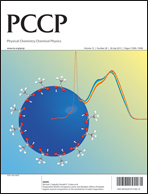Ultraslow relaxation of the structure at the ionic liquid|gold electrode interface to a potential step probed by electrochemical surface plasmon resonance measurements: asymmetry of the relaxation time to the potential-step direction†
Abstract
The relaxation of the structure in the electrical double layer at the ionic liquid|gold interface to the steps of the electrode potential has been studied using


 Please wait while we load your content...
Please wait while we load your content...